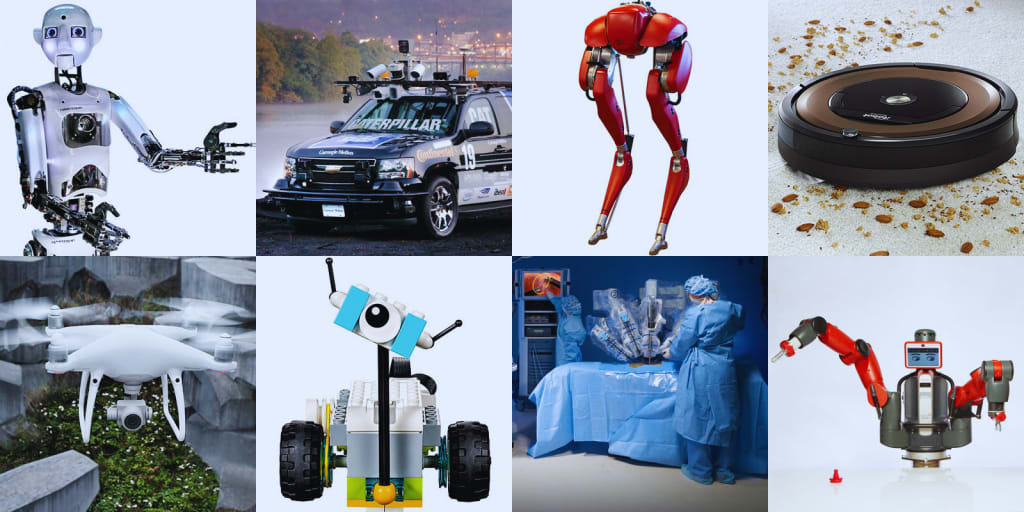
ROBOTICS
Robotics is the field of engineering and science that deals with the design, construction, operation, and use of robots. A robot is a machine that is capable of carrying out tasks autonomously or with minimal human intervention. Robotics involves many disciplines such as mechanical engineering, electrical engineering, computer science, and artificial intelligence..Robots can be classified into different types based on their design, capabilities, and applications. Some examples include:
Industrial robots:
These robots are used in manufacturing industries for tasks such as assembly, welding, painting, and packaging. Industrial robots are robotic systems that are designed and built for use in manufacturing and industrial settings. These robots are typically used to perform repetitive, dangerous, or precise tasks that would otherwise be difficult or impossible for humans to carry out. Industrial robots are used in many industries, including automotive manufacturing, electronics, food and beverage, and pharmaceuticals.
Some common applications of industrial robots include:
Assembly: Robots can perform repetitive assembly tasks such as screwing, gluing, and welding components together.
Material handling: Robots can move and transport materials from one location to another, such as loading and unloading heavy or hazardous materials.
Painting: Robots can paint large or complex surfaces with precision and consistency.
Quality control: Robots can inspect and test products for defects or deviations from specifications.
Packaging: Robots can pack and palletize products for shipping and storage.
Mobile robots:
These robots can move around and operate in various environments, such as on wheels, tracks, or legs. Mobile robots are robots that are capable of movement and can navigate and perform tasks in their environment. They are often used in various applications such as manufacturing, agriculture, healthcare, and security. Mobile robots can be classified into different categories based on their locomotion systems, such as wheeled robots, legged robots, aerial robots, underwater robots, and even crawling robots.
Wheeled robots are the most common type of mobile robots and are often used in industrial applications for material handling and transportation. Legged robots, on the other hand, are used in situations where wheeled robots cannot operate, such as on uneven terrain or in areas with obstacles. Aerial robots, also known as drones, are used for surveillance, search and rescue, and aerial photography. Underwater robots are used for exploring the ocean depths, and crawling robots are used in confined spaces where other robots cannot reach.
Humanoid robots:
These robots are designed to resemble humans in appearance and behavior, and they can perform tasks such as communication and social interaction. Humanoid robots are robots that are designed to resemble and mimic human-like characteristics and behavior, such as walking on two legs, using hands to manipulate objects, and communicating with people. They are often equipped with sensors, cameras, and other advanced technologies that allow them to perceive and interact with their environment. The development of humanoid robots has been driven by a wide range of applications, including manufacturing, healthcare, education, entertainment, and space exploration. For example, humanoid robots can be used in manufacturing to perform repetitive or dangerous tasks that would otherwise be performed by human workers. In healthcare, they can assist patients with mobility and other activities of daily living, or serve as assistants to medical professionals. In education, they can be used to teach students about science, technology, engineering, and mathematics (STEM) concepts. Some of the most well-known humanoid robots include ASIMO, developed by Honda, and Atlas, developed by Boston Dynamics. These robots are equipped with advanced sensors and control systems that allow them to walk, run, climb stairs, and perform other complex movements with a high degree of accuracy and precision.While humanoid robots hold a lot of promise for the future, there are also concerns about their potential impact on society, particularly in terms of job displacement and privacy. As such, it's important for developers and policymakers to carefully consider the ethical implications of their use and ensure that they are designed and deployed in ways that are safe, responsible, and beneficial to society as a whole.
Service robots:
These robots are designed to assist humans in various tasks, such as healthcare, education, and entertainment. Service robots are robots designed to perform a range of tasks in a variety of settings, including homes, offices, hospitals, and public spaces. They are typically equipped with advanced sensors, actuators, and control systems that allow them to perceive and interact with their environment in a meaningful way. Service robots can be used for a wide range of applications, including cleaning, cooking, healthcare, entertainment, and education. For example, a service robot may be used to vacuum floors or mow lawns, freeing up time for people to focus on other tasks. In healthcare, service robots can be used to assist with patient care, medication management, and monitoring vital signs.One of the key benefits of service robots is their ability to perform tasks that may be too dangerous or difficult for humans, such as working in hazardous environments or lifting heavy objects. They can also provide assistance to people with disabilities or mobility impairments, allowing them to live more independently.Examples of service robots include the Roomba vacuum cleaner, which can clean floors autonomously, and the Pepper robot, which can interact with people and provide information in public spaces.





Comments
There are no comments for this story
Be the first to respond and start the conversation.